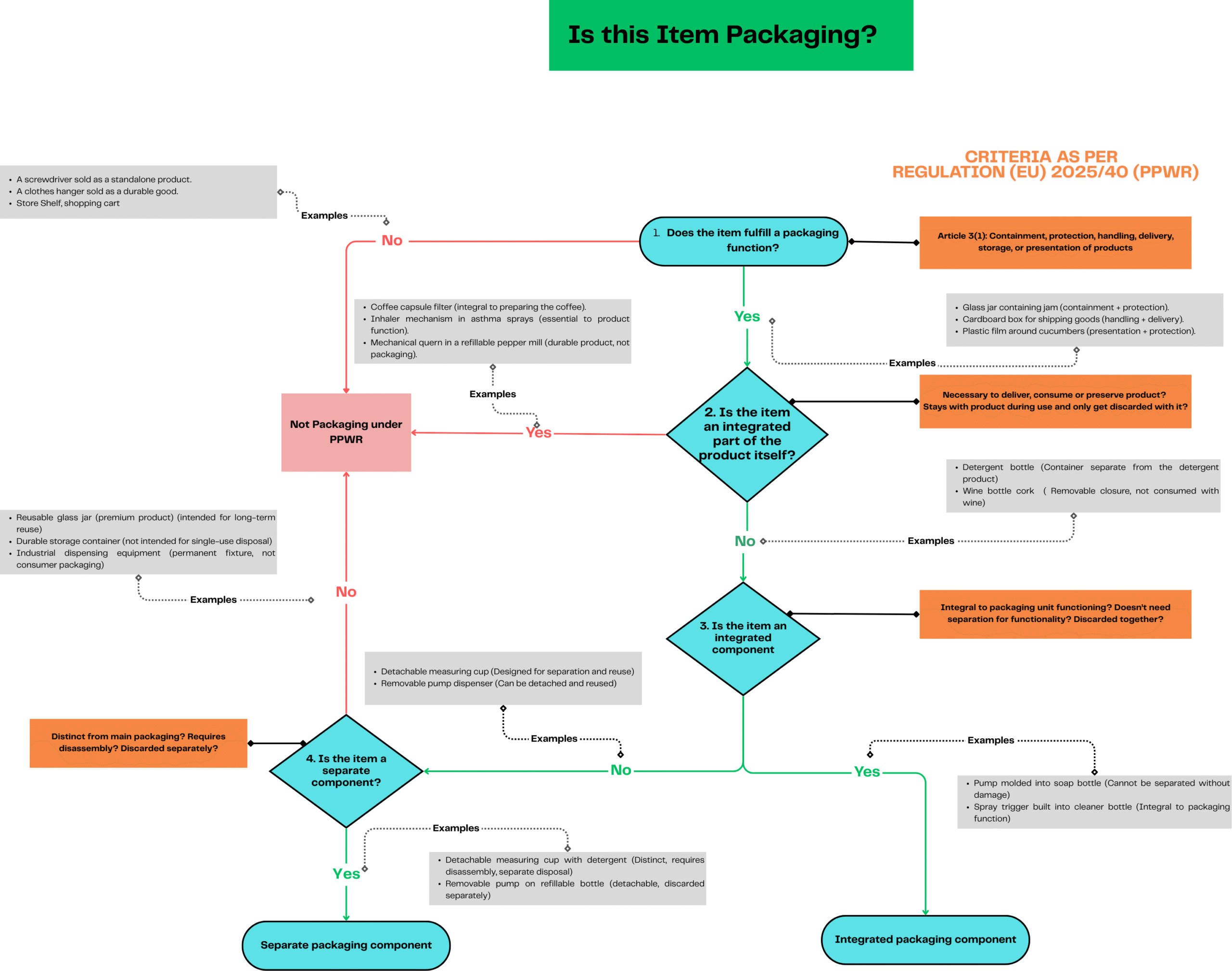The EU Packaging and Packaging Waste Regulation (PPWR), which came into force in February 2025, is transforming how businesses design, classify, and manage packaging across Europe. With ambitious goals to make all packaging recyclable, reusable, and increasingly circular by 2030, this regulation establishes a harmonized set of rules that demand rigor and transparency from producers, importers, and retailers alike.
The PPWR Packaging Classification Decision Tree
The regulation defines packaging, and provides a systematic four-step process to determine if an item is packaging, and what compliance obligations apply.
Step 1: Is it performing a packaging function?
Legal Reference: Article 3(1)
Criteria: Does the item provide containment, protection, handling, delivery, storage, or presentation of products?
- YES → Proceed to Step 2
- NO → Not regulated packaging (no PPWR obligations)
Step 2: Is it an integrated part of the product itself?
Legal Reference: Recital 13 + Annex I examples
Criteria: Is it necessary to deliver, consume, or preserve the product (e.g., tea bag material, sausage casings, medical inhaler casing)? Does it stay with the product throughout use and get discarded only with it?
- YES → Considered ‘part of the product’, not packaging under PPWR
- NO → Proceed to Step 3
Step 3: Is it an integrated component of the packaging?
Legal Reference: Article 3(1), point (43)
Criteria: Is the item integral to packaging functioning, not requiring separation for use, and typically discarded together with the packaging unit (e.g., a pump permanently molded into a soap bottle, an attached trigger spray)?
- YES → Integrated packaging component
- NO → Proceed to Step 4
Step 4: Is it a separate component?
Legal Reference: Article 3(1), point (44)
Criteria: Is it distinct from the packaging, requiring disassembly/separation for disposal, and usually discarded separately (e.g., a detachable measuring cup, a removable pump)?
- YES → Separate packaging component
- NO → Not packaging

PPWR Component Obligations: Integrated vs Separate Components
The distinction between integrated packaging components and separate packaging components defines the compliance burden for manufacturers, packers, and brand owners.
Integrated Components
- Definition: Permanently attached; not meant to be separated before disposal.
- Obligations:
- Assessed collectively with the main packaging unit
- Subject to overall packaging recyclability rating (Grades A, B, C)
- EPR (Extended Producer Responsibility) fees modulated according to the packaging’s collective recyclability and design performance
- Documentation included in the packaging’s technical file
- Shared market access and harmonized labeling
Separate Components
- Definition: Designed to be detachable or separated and discarded separately from the main packaging unit.
- Obligations:
- Must be individually assessed for recyclability and design-for-recycling criteria
- EPR fees calculated and modulated per component
- Requires individual compliance documentation and registration
- Separate labeling and market access requirements
- Each component must meet minimum thresholds from 2030 (Grade C or better); lower-performing components (Grade D/E) are penalized and will be phased out
Why This Matters
From 2030, only packaging (and components) with recyclability grades A, B, or C may be marketed in the EU—with stricter standards in future years. Non-compliant items may result in fines, denied market access, or withdrawal obligations.
While integrated components are generally easier and less costly to manage (collective obligations), separate components can dramatically increase compliance burden and costs due to per-item assessment, documentation, and EPR fee calculations.
Preparation: Key Actions for Producers and Brand Owners
- Audit Your Packaging: Use the four-step classification tree for all items associated with the product.
- Design for Integration: Where possible, choose integrated components over separate ones to optimize compliance and minimize costs.
- Monitor Regulatory Timelines: 2030 is the big threshold, but 2026 (general application), 2028 (EPR registration, harmonized labeling), and 2035 (recyclability at scale) are also critical.
- Documentation: Prepare for robust recordkeeping: supply chain audits, test certificates, supplier declarations, and quarterly recycling performance reports.
Final Thoughts
The PPWR classification decision tree is not just an academic exercise: it’s how producers and brand owners make compliance part of design and procurement. Understanding the obligations for integrated versus separate components will not just save costs and avoid headaches—it is the foundation for sustainable, legal, and competitive packaging in the new European market.
